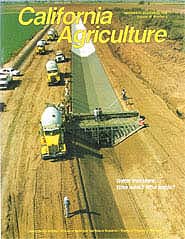All Issues

Water transfers: Who wins? Who loses?
Cover:
Workers line the South Alamo Canal with concrete, a project involving 150 miles of existing earthen lateral and main canals in the Imperial Irrigation District (IID). The lining prevents ground seepage, a conservation measure funded under the historic water transfer agreement between IID and Metropolitan Water District (MWD). It will allow the capture of previously lost water for use by MWD.
Photo by Don Harvey, courtesy of IID
November-December 1992
Volume 46, Number 6
Volume 46, Number 6





